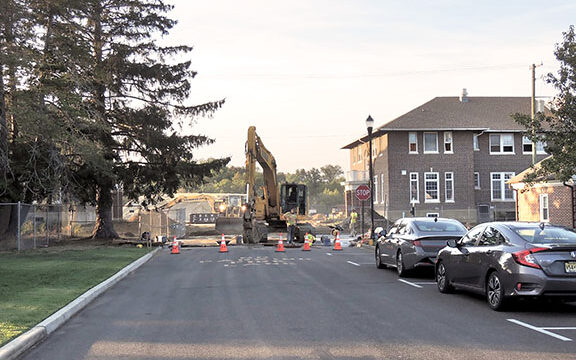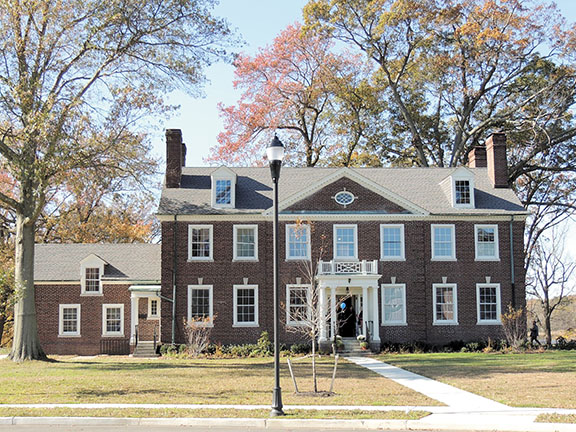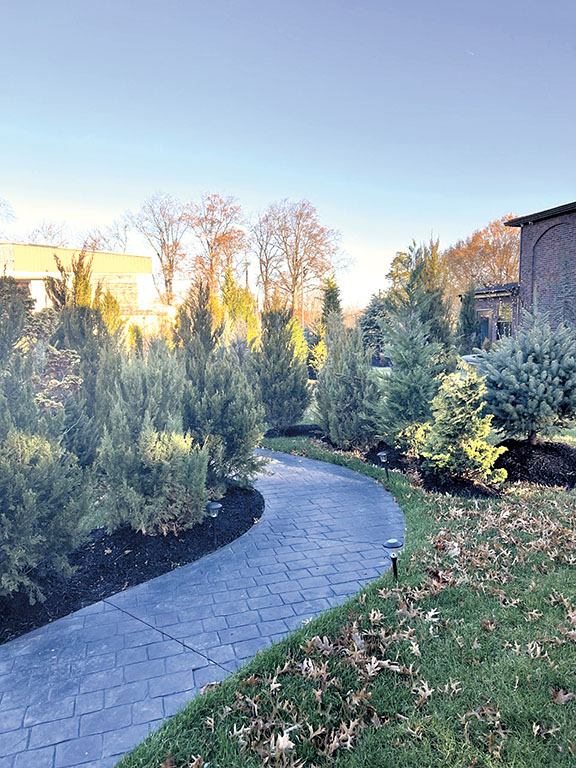
By Laura D.C. Kolnoski
FORT MONMOUTH – Major Fort Monmouth redevelopment projects that have been advancing through local, county and state bureaucracies for years are now becoming reality on the former U.S. Army base, causing disruption and some concern for a few neighbors.
Two homeowners in East Gate, the fort’s first residential project opened in 2018, attended the September meeting of the Fort Monmouth Economic Revitalization Authority (FMERA), seeking relief from construction vehicles driving through their streets, sometimes speeding and going in the wrong direction. Shortly thereafter, new traffic signs were installed directing construction traffic away from interior East Gate streets.
Two other citizens subsequently contacted The Two River Times citing concerns over tree removal resulting from the redevelopments, one a member of the Little Silver Environmental Commission, the other the new owner of the General’s House, located in the fort’s historic district at the end of East Gate along Parkers Creek.
Sandra Talarico, a two-year member of the Little Silver Environmental Commission, expressed dismay over tree removal along Oceanport Avenue, where adjoining projects by different developers will mix residential, retail, commercial and entertainment uses.
“The letter to the editor I sent was based on my own environmental awareness and a lifelong commitment to our environment,” Talarico wrote in an email Dec. 5. “The area along the west side of Oceanport Avenue on Fort Monmouth has been clear cut of many mature trees. Not only did those trees provide nesting sites, food, and shelter for animals and insects, they also absorbed water in an area that regularly floods. Trees mitigate flooding, prevent erosion and sediment from going into waterways, and are an integral part of the ecosystem.”

Talarico said Little Silver is developing a tree ordinance, adding, “Citizens in Little Silver became dismayed watching developers clear cut lots before building.”
“As a member of the Environmental Commission, a citizen of the town, and an environmentalist, I support the ordinance,” she said.
Bob and Diane Baxter purchased the General’s House in early 2021 and are in the process of renovating it prior to moving in early next year. The couple has been living with their son, one of the first residents of East Gate, created from 100-year-old Officers Row housing opposite the fort’s Parade Grounds.
“No one is against developing the fort, but it’s a series of missed opportunities to make everyone’s property better,” Bob Baxter said Dec. 3. “There is no sensitivity to the surroundings.” The Baxters previously rescued and renovated the superintendent’s home on the former historic Rohallion Estate in Rumson.
He called the developments “shockingly dense” with insufficient green buffers and a lack of adherence to the area’s historic character. Diane Baxter said she contacted FMERA and the Borough of Oceanport but has so far gotten “the runaround. East Gate residents are exposed when they were supposed to be protected.”
The Baxters cited Park Loft, the recently opened new banquet hall in the fort’s renovated 1940s Dance Hall as “an excellent example of what good improvement at Fort Monmouth can look like.” To date, over 200 trees have been planted on that site according to Park Loft owner Trip Brooks, who said he is “still planting.”
Different firms are involved in the ongoing construction in Oceanport. (The 1,126-acre fort spans portions of Eatontown, Oceanport and Tinton Falls.) A 15-acre site is being transformed into 144 townhomes and 36 affordable residential units by Somerset Development of Lakewood and Holmdel. Work includes demolition of some original structures and adaptive reuse of two historic buildings in what was formerly the Lodging Area. Somerset subleased a portion of its property to PulteGroup, which is building three-story townhouses ranging from 1,980 to 2,378 square feet.

Adjacent along Signal Avenue is the 12-acre waterfront Allison Hall parcel being redeveloped by Fort Monmouth Business Center, LLC, an assignee of TetherView Property Management, owned by Michael Abboud of Oceanport who also purchased and renovated nearby Russel Hall. The site will become Riverwalk Center, to include a variety of uses including a waterfront restaurant and potentially a boutique hotel. Each developer along the creek must construct their portion of a connecting public pedestrian promenade.
The fort’s master Reuse Plan, devised a decade ago and modified over time, includes the state-mandated creation of 1,585 housing units of varying types, 20 percent of which must be affordable housing.
“With such a large-scale redevelopment ongoing, it’s important to provide a larger picture regarding the changes to the fort’s landscape,” wrote Sarah Giberson, FMERA senior marketing and development officer, in an email to The Two River Times, adding that since many fort buildings are obsolete and/or no longer viable, changes should be expected “to clear blight and make way for new improvements.” She said several Army-owned landfills have been capped or are undergoing the capping process which requires all trees be cleared, a process managed by the Army.
“Unfortunately, this results in mature trees facing removal, but ultimately it is for the benefit of the property’s future use, from an access and environmental safety perspective,” Giberson continued. “FMERA is extremely mindful of the wildlife that call the fort home.” She said landfills have been reseeded and planted with native wildflowers, with one “targeted for partial preservation as a wildlife foraging area.” She noted birds like osprey prefer nesting in clear areas to avoid predators like bald eagles who hide in tall trees. FMERA currently maintains over 40 nesting platforms and follows New Jersey Department of Environmental Protection guidance regarding appropriate locations of nesting sites.
FMERA’s Land Use Rules regulate impervious coverage. Coverage is reviewed by a FMERA planner and environmental officer, followed by the respective municipality. Developers provide grading and drainage plans, landscape plans, and sediment control information, while both parties evaluate engineering controls to manage potential environmental impacts. FMERA defers to NJDEP standards where applicable, and encourages green building and sustainability measures, Giberson said. Additionally, the authority works with Monmouth County and the municipalities to remove brush and trees “when there is a potential threat to life and safety. Some of our mature landscaping has not been able to weather all storms like the effects of Superstorm Sandy and other harsh nor’easter events.”
The article originally appeared in the December 15 – 21, 2022 print edition of The Two River Times.














